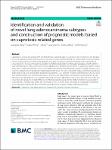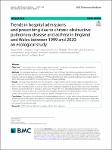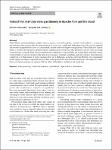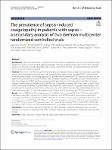Search
Author
- Osman, Ahmed I. (5)
- Daqing, Ma (3)
- Jorgensen, Ed (3)
- Li, Yan (3)
- next >
Subject
- kinh tế (26)
- Economics (12)
- programming (10)
- XRD (10)
- next >
Date issued
- 2020 - 2025 (2128)
- 2010 - 2019 (129)
- 2000 - 2009 (9)
- 1999 - 1999 (1)
Has File(s)
Search Results
Postoperative death is the third leading cause of death in the world, but the quality of death after surgery has been poorly documented. This study aimed to evaluate the feasibility of a questionnaire survey for the bereaved family regarding the postoperative quality of death and the impact of preoperative functional disability on the quality of death. |
The Global South and Global North terminologies, in addition to several other designations, have been used to classify the socio-economic nature of countries for centuries; however, these historical naming conventions carry subtle confusions and tend to tint political discourse. This research explores the classificatory differences in international trade, politics, economic theory, and the media and discusses how such differences inform the narratives surrounding world production and consumption systems, as well as trade. The current evidence suggests that several descriptions of the world economies create misunderstandings and often mischaracterize less developed countries while positively projecting certain countries as more advanced. |
The purpose of this paper is to explore the use of deep learning for the solution of the nonlinear filtering problem. This is achieved by solving the Zakai equation by a deep splitting method, previously developed for approximate solution of (stochastic) partial differential equations. This is combined with an energy-based model for the approximation of functions by a deep neural network. This results in a computationally fast filter that takes observations as input and that does not require re-training when new observations are received. The method is tested on four examples, two linear in one and twenty dimensions and two nonlinear in one dimension. The method shows promising performance when benchmarked against the Kalman filter and the bootstrap particle filter. |
To investigate the trends in hospital admissions and medication prescriptions related to asthma and chronic obstructive pulmonary disease (COPD) in England and Wales. |
Rather than present students with a broad, novice-level introduction to geography, emphasizing places and vocabulary terms, this text approaches geography as experts understand the discipline, focusing on connections and an in-depth understanding of core themes. This thematic approach, informed by pedagogical research, provides students with an introduction to thinking geographically. Instead of repeating the same several themes each chapter, this text emphasizes depth over breadth by arranging each chapter around a central theme and then exploring that theme in detail as it applies to the particular region. In addition, while chapters are designed to stand alone and be rearranged or eliminated at the instructor's discretion, the theme of globalization and inequality unites all of t... |
Video2Flink is a distributed highly scalable video processing system for bounded (i.e., stored) or unbounded (i.e., continuous) and real-time video streams with the same efficiency. It shows how complicated video processing tasks can be expressed and executed as pipelined data flows on Apache Flink, an open-source stream processing platform. Video2Flink uses Apache Kafka to facilitate the machine-to-machine (m2m) communication between the video production and the video processing system that runs on Apache Flink. Features that make the combination of Apache Kafka and Apache Flink a desirable solution to the problem of video processing are the ease of customization, portability, scalability, and fault tolerance. |
This paper proposes a synthetic indicator of the quality of support for companies and identifies the factors that can contribute towards improving the quality of such support in three countries (i.e., Burkina-Faso, Cameroon, and Ghana). The study uses static mechanics and applies techniques of factor analysis. A principal component analysis is performed on the data collected from 80 business support structures in the sampled countries. After constructing the indicators, correlates are provided on how the constructed indicators are linked to the objectives of sustainable development. Our results are robust after controlling for variables relating to the general characteristics of the support structure. The findings are consistent with the position that taking sustainable development ... |
I numerically compute Borda-optimal, i.e., optimal based on the Borda count as the normative criterion, labour-income tax schedules for the United States. I do so in the context of a Mirrlees-style model with quasilinear preferences and a constant elasticity of labour supply. Because the Borda count is defined for finitely many alternatives, the computations restrict attention to a finite subset of the set of continuous, piecewise linear tax schedules with (in the baseline analysis) four or fewer pieces. |
Sepsis and septic shock are frequently accompanied by coagulopathy. Since the sepsis-induced coagulopathy (SIC) score was first described, subsequent studies from Asia revealed a SIC prevalence of 40–60%. In Europe, however, SIC prevalence in patients fulfilling sepsis criteria according to the third international consensus definition (SEPSIS-3) has not yet been evaluated. |
This article aims to provide a virtual reconstruction of the skyscraper Hotel Attraction based on the original documentation, which makes it possible to analyze the project and propose hypotheses regarding the contradictory information in the original drawings. The geometry of the project has been defined using a physics-based simulation, emulating Gaudí’s methodology in his models. To define the curves, a model based on weighted hanging chains has been generated, using a system with springs and particles. |










